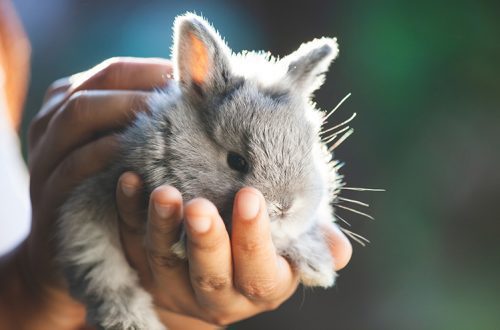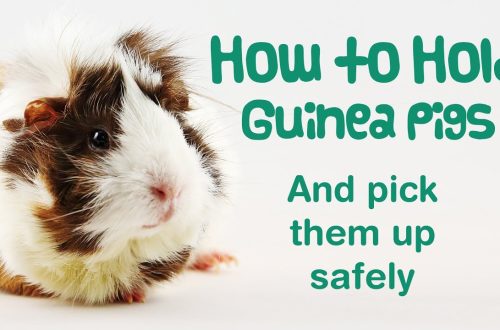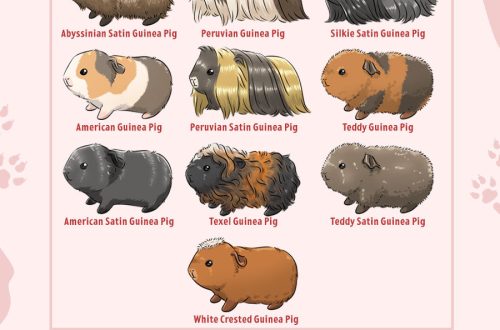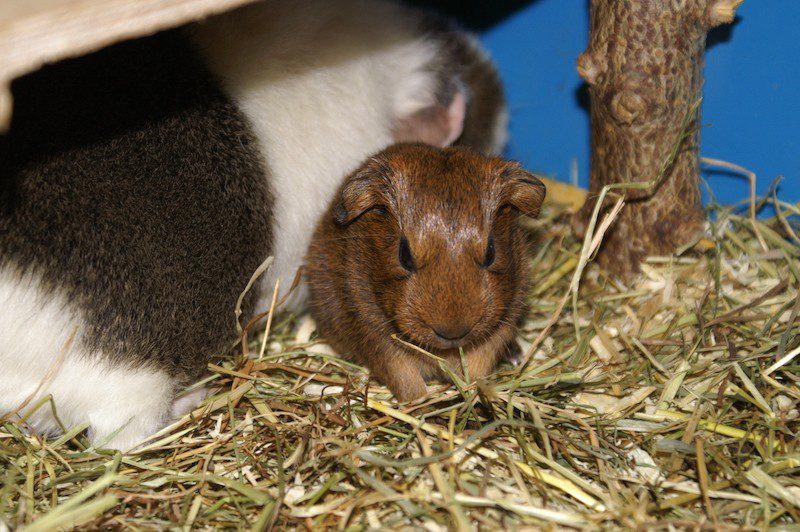
Postpartum complications in guinea pigs
Contents
- How are guinea pigs giving birth?
- Bleeding in a guinea pig after childbirth
- The female does not break the fetal membranes of newborns
- Guinea pig refuses to feed
- Inflammation of the nipples in guinea pigs
- mastitis in guinea pig
- Lack of milk in a guinea pig
- Skin and coat problems after childbirth in a guinea pig
How are guinea pigs giving birth?
Below is the perfect picture of a successful birth that all guinea pig breeders love to see.
After the female has thoroughly licked the newborns and cleaned herself, she should allow the cubs to suckle milk. The first thing you should see, if the birth went well, is the female sitting in the corner of the cage with all her cubs around; cubs should be clean and dry, some of them will suckle milk. There should be no or very little blood on the bedding, and you may also see a couple of afterbirths that the mumps will leave uneaten. After a normal birth, the mumps feels hungry and nurses the cubs with great care and love. Shortly after birth, the cubs are already able to run, and within the first 48 hours they will already begin to eat solid food.
It is normal for pups to lose some weight in the first 3 or 4 days, but then they will quickly gain weight and should reach their original weight no later than the end of the first week of life. Their eyes should remain shiny, and the cubs themselves should not look skinny, hunched over, and their coat should not be prickly.
A normal female will lose weight in the case of a multiple litter, but only if she maintains a good appetite and looks healthy. After she stops breastfeeding her young, she will gain weight quickly.
Below is the perfect picture of a successful birth that all guinea pig breeders love to see.
After the female has thoroughly licked the newborns and cleaned herself, she should allow the cubs to suckle milk. The first thing you should see, if the birth went well, is the female sitting in the corner of the cage with all her cubs around; cubs should be clean and dry, some of them will suckle milk. There should be no or very little blood on the bedding, and you may also see a couple of afterbirths that the mumps will leave uneaten. After a normal birth, the mumps feels hungry and nurses the cubs with great care and love. Shortly after birth, the cubs are already able to run, and within the first 48 hours they will already begin to eat solid food.
It is normal for pups to lose some weight in the first 3 or 4 days, but then they will quickly gain weight and should reach their original weight no later than the end of the first week of life. Their eyes should remain shiny, and the cubs themselves should not look skinny, hunched over, and their coat should not be prickly.
A normal female will lose weight in the case of a multiple litter, but only if she maintains a good appetite and looks healthy. After she stops breastfeeding her young, she will gain weight quickly.
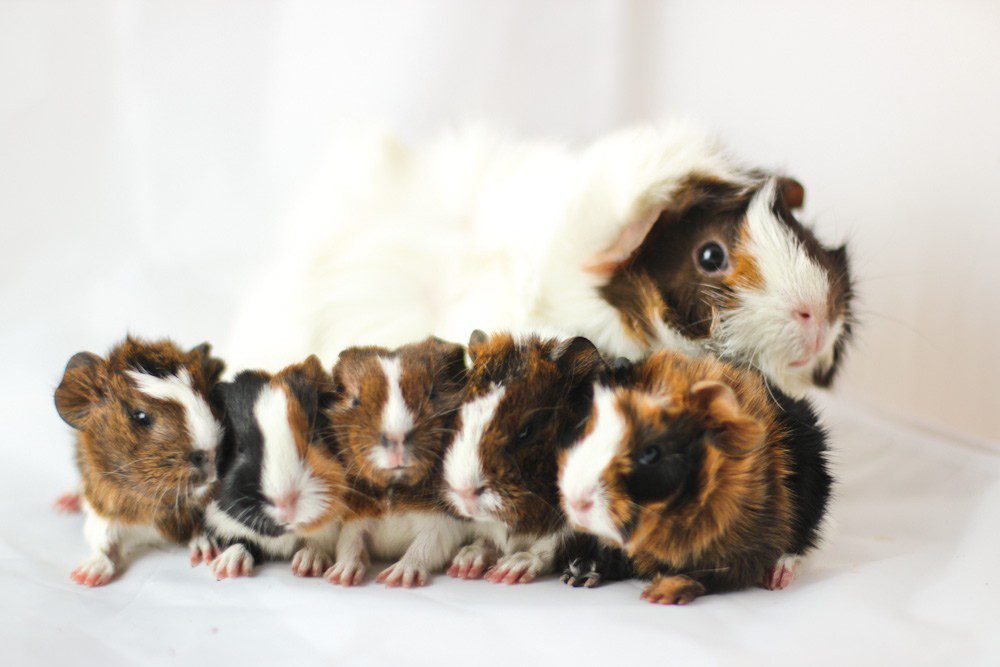
Bleeding in a guinea pig after childbirth
During the next two days after giving birth, the female may experience light bleeding from the birth canal, after which the vaginal membrane closes. If the bleeding is heavy or the blood has an unpleasant odor, or the mumps is not active enough, then this may indicate an afterbirth or fetus remaining in the uterus. The guinea pig should be taken to the veterinarian immediately.
During the next two days after giving birth, the female may experience light bleeding from the birth canal, after which the vaginal membrane closes. If the bleeding is heavy or the blood has an unpleasant odor, or the mumps is not active enough, then this may indicate an afterbirth or fetus remaining in the uterus. The guinea pig should be taken to the veterinarian immediately.
The female does not break the fetal membranes of newborns
In the uterine cavity, the fetuses are in the fetal membranes filled with fluid. During childbirth, the female pulls out the fetus with her teeth and thus breaks the fetal membranes. If this does not happen for any reason, the fetus will die from suffocation.
If the birth takes place in the presence of the owner, then he himself can free such a cub from the membranes. To do this, you need to break the film near the muzzle of the newborn, clear the oral cavity and nose of mucus and, holding it tightly in your hand, shake the cub strongly several times. This helps to restore breathing. Next, wipe it thoroughly with a soft cloth. Next, it is important not to give him anything to drink.
The newborn should be placed close to a heat source, such as a bottle of warm water, and kept warm. After about an hour, when the cub can move on its own, it can be placed next to its mother. But since she did not lick the cub, she does not recognize it as her own, so it must be carefully placed under the female’s stomach and ensured that she accepts it.
If the female rejects the cub, you can try again later, but if she continues to chase him away, you will have to artificially feed the cub.
In the uterine cavity, the fetuses are in the fetal membranes filled with fluid. During childbirth, the female pulls out the fetus with her teeth and thus breaks the fetal membranes. If this does not happen for any reason, the fetus will die from suffocation.
If the birth takes place in the presence of the owner, then he himself can free such a cub from the membranes. To do this, you need to break the film near the muzzle of the newborn, clear the oral cavity and nose of mucus and, holding it tightly in your hand, shake the cub strongly several times. This helps to restore breathing. Next, wipe it thoroughly with a soft cloth. Next, it is important not to give him anything to drink.
The newborn should be placed close to a heat source, such as a bottle of warm water, and kept warm. After about an hour, when the cub can move on its own, it can be placed next to its mother. But since she did not lick the cub, she does not recognize it as her own, so it must be carefully placed under the female’s stomach and ensured that she accepts it.
If the female rejects the cub, you can try again later, but if she continues to chase him away, you will have to artificially feed the cub.
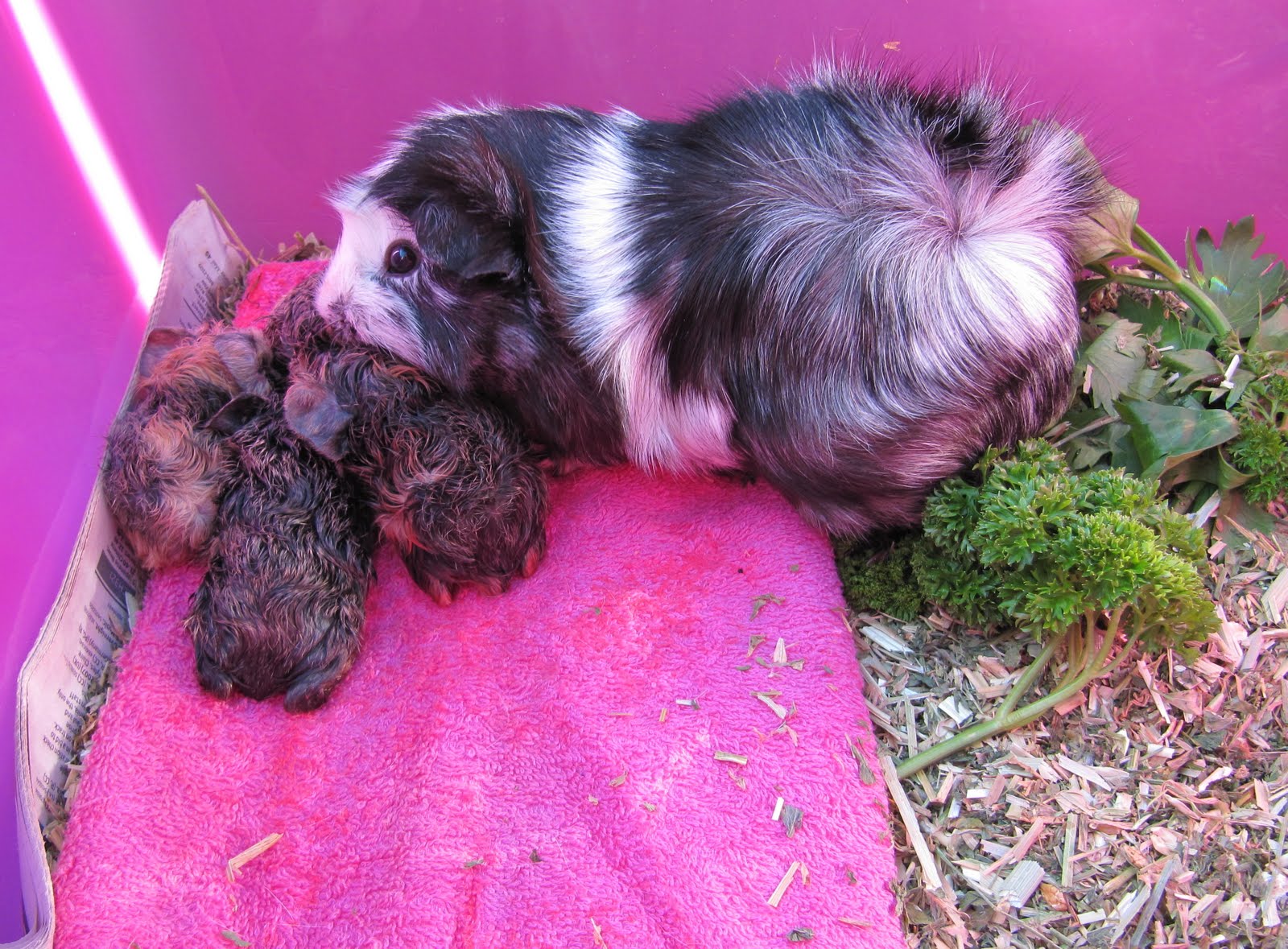
Guinea pig refuses to feed
Sometimes the female refuses to feed the cubs. Most often this occurs in primiparous females, as it can be difficult for them to quickly adapt to the state of sudden motherhood. Such pigs must be left to themselves and the cubs, providing peace and quiet. If that doesn’t solve the problem after 6-8 hours, then you can try the following: put them in a small dark box with not enough room to run away in a panic. As soon as the female allows the cubs to suck milk and begins to care for them, it means that she has accepted and learned the role of the mother, and then everything will be in perfect order.
Babies won’t really get hungry for the first 12 hours. However, if the female continues to refuse to feed, you will have to resort to artificial feeding or try to find a foster mother for the cubs. You must hurry, otherwise they will die of hunger.
Most females are better prepared the next time they give birth and will nurse the young properly. But a female who also refuses to feed the next brood should not be used for breeding, as the lack of maternal instinct can be inherited by surviving cubs. Alternatively, mild sedatives may be administered until the female accepts the cubs, but for the reasons mentioned above, this female should not be used in breeding work.
Sometimes the female refuses to feed the cubs. Most often this occurs in primiparous females, as it can be difficult for them to quickly adapt to the state of sudden motherhood. Such pigs must be left to themselves and the cubs, providing peace and quiet. If that doesn’t solve the problem after 6-8 hours, then you can try the following: put them in a small dark box with not enough room to run away in a panic. As soon as the female allows the cubs to suck milk and begins to care for them, it means that she has accepted and learned the role of the mother, and then everything will be in perfect order.
Babies won’t really get hungry for the first 12 hours. However, if the female continues to refuse to feed, you will have to resort to artificial feeding or try to find a foster mother for the cubs. You must hurry, otherwise they will die of hunger.
Most females are better prepared the next time they give birth and will nurse the young properly. But a female who also refuses to feed the next brood should not be used for breeding, as the lack of maternal instinct can be inherited by surviving cubs. Alternatively, mild sedatives may be administered until the female accepts the cubs, but for the reasons mentioned above, this female should not be used in breeding work.
Inflammation of the nipples in guinea pigs
This problem occurs from time to time, especially in the case of multiple litters. The female experiences discomfort during feeding, and extensive damage may appear on the skin and coat. Wash the wounds and adjacent skin areas with a decoction of chamomile or a mild disinfectant solution, then rub a soothing, softening ointment into the skin.
Be careful not to use products that could be harmful if swallowed by pups. You can safely use the medicine for inflammation of the nipples used by people. Infection of the skin on and around the nipples can spread to the breast and cause mastitis.
This problem occurs from time to time, especially in the case of multiple litters. The female experiences discomfort during feeding, and extensive damage may appear on the skin and coat. Wash the wounds and adjacent skin areas with a decoction of chamomile or a mild disinfectant solution, then rub a soothing, softening ointment into the skin.
Be careful not to use products that could be harmful if swallowed by pups. You can safely use the medicine for inflammation of the nipples used by people. Infection of the skin on and around the nipples can spread to the breast and cause mastitis.
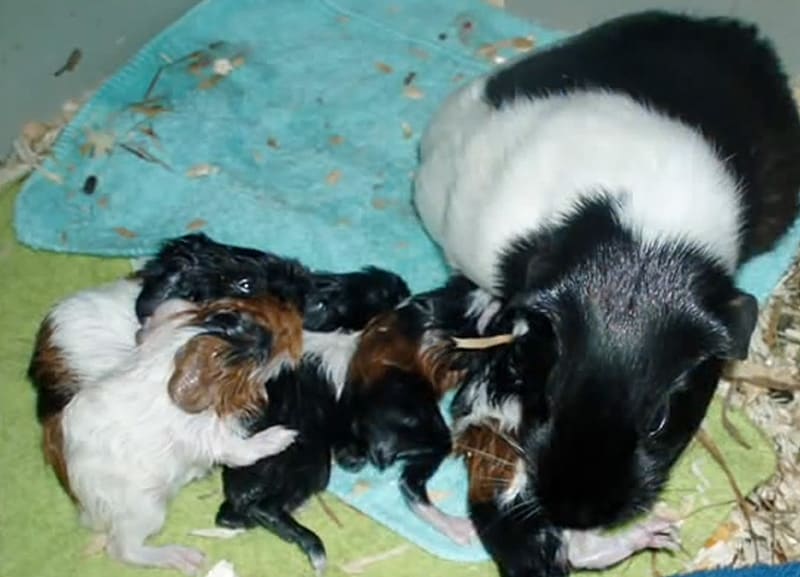
mastitis in guinea pig
Mastitis is an infection of the breast. The gland becomes red, warm, hard and swollen. Milk thickens and acquires a yellowish tint. Most females eat and generally appear normal, but occasional fever and loss of appetite occur. Expressing milk is a necessary part of treatment. To do this, gently squeeze the nipple with your fingers several times a day, then wipe it with a cotton swab with warm, slightly soapy water and rinse with clean water.
This treatment, along with a gentle massage of the skin, improves blood flow and promotes healing. If the female loses her appetite or does not improve within a few days, a veterinarian should be consulted for further treatment, which may also include antibiotic treatment (see article Antibiotics and Guinea Pigs).
In difficult cases, microbiological analysis with cultures may be recommended to determine which antibiotics have the best effect. All existing cell hygiene problems (if any) must be addressed to avoid similar diseases in the future.
Mastitis is an infection of the breast. The gland becomes red, warm, hard and swollen. Milk thickens and acquires a yellowish tint. Most females eat and generally appear normal, but occasional fever and loss of appetite occur. Expressing milk is a necessary part of treatment. To do this, gently squeeze the nipple with your fingers several times a day, then wipe it with a cotton swab with warm, slightly soapy water and rinse with clean water.
This treatment, along with a gentle massage of the skin, improves blood flow and promotes healing. If the female loses her appetite or does not improve within a few days, a veterinarian should be consulted for further treatment, which may also include antibiotic treatment (see article Antibiotics and Guinea Pigs).
In difficult cases, microbiological analysis with cultures may be recommended to determine which antibiotics have the best effect. All existing cell hygiene problems (if any) must be addressed to avoid similar diseases in the future.
Lack of milk in a guinea pig
In this regard, the cubs will soon weaken, and some of them (or even all) may die. Lack of milk can be caused by stress or mastitis, and if the milk does not return, the cubs will have to be artificially fed or try to find a foster mother for them. But above all, try to leave mother and cubs together in a calm, quiet environment, providing them with an abundance of juicy greens and vegetables, as well as the highest quality hay that can be obtained. Often the problem resolves itself within 24 hours. However, in the case of mastitis in a female, the treatment described above should be resorted to.
In this regard, the cubs will soon weaken, and some of them (or even all) may die. Lack of milk can be caused by stress or mastitis, and if the milk does not return, the cubs will have to be artificially fed or try to find a foster mother for them. But above all, try to leave mother and cubs together in a calm, quiet environment, providing them with an abundance of juicy greens and vegetables, as well as the highest quality hay that can be obtained. Often the problem resolves itself within 24 hours. However, in the case of mastitis in a female, the treatment described above should be resorted to.
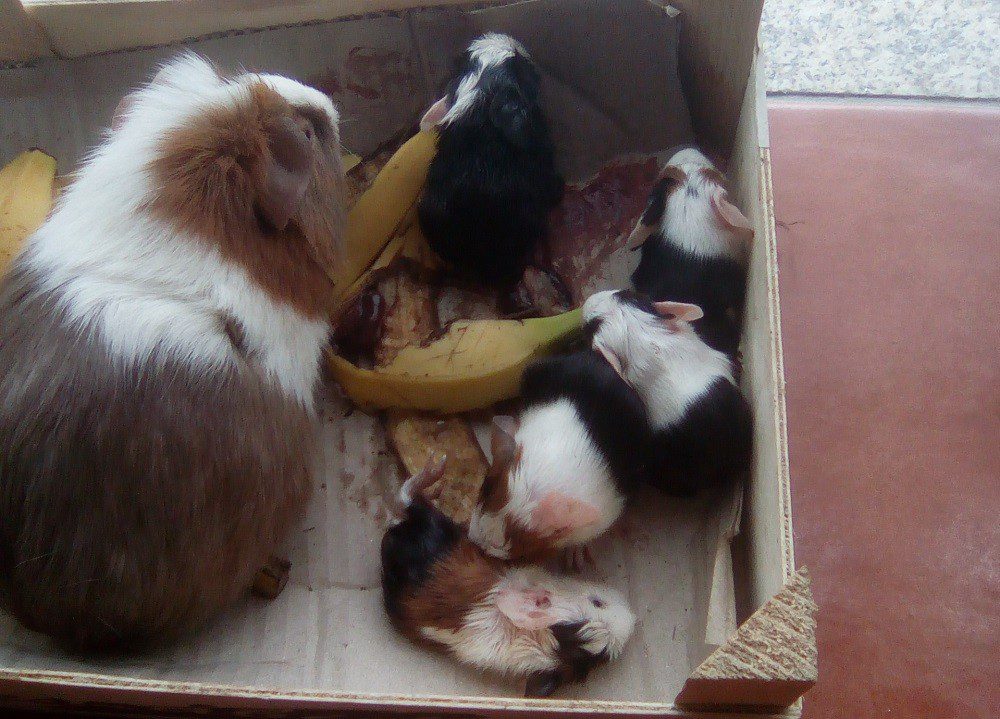
Skin and coat problems after childbirth in a guinea pig
After giving birth, the female may lose some hair due to birth hormonal changes and influences. Most often, areas with broken coat appear symmetrically on the sacrum. There are also bald patches. If the skin develops sores and tears, wash them with a mild disinfectant solution daily. Don’t worry, normal hair growth will begin in about a week or two.
You may also experience a special type of tissue damage to your back. This is likely due to malnutrition and should be corrected to avoid further problems. Every day – until it passes – the damage must be washed, and then rubbed with a soothing, softening ointment. In the event of an infection, a veterinarian should be consulted immediately.
Once in my practice, I encountered a situation where a cub lost all of its coat a few days after birth. He looked healthy, with sparkling eyes, and within 4 weeks his coat was completely normal again.
After giving birth, the female may lose some hair due to birth hormonal changes and influences. Most often, areas with broken coat appear symmetrically on the sacrum. There are also bald patches. If the skin develops sores and tears, wash them with a mild disinfectant solution daily. Don’t worry, normal hair growth will begin in about a week or two.
You may also experience a special type of tissue damage to your back. This is likely due to malnutrition and should be corrected to avoid further problems. Every day – until it passes – the damage must be washed, and then rubbed with a soothing, softening ointment. In the event of an infection, a veterinarian should be consulted immediately.
Once in my practice, I encountered a situation where a cub lost all of its coat a few days after birth. He looked healthy, with sparkling eyes, and within 4 weeks his coat was completely normal again.
© Mette Lybek Ruelokke
The original article is located at http://www.oginet.com/Cavies/cvbirpo.htm.
© Translation by Elena Lyubimtseva
© Mette Lybek Ruelokke
The original article is located at http://www.oginet.com/Cavies/cvbirpo.htm.
© Translation by Elena Lyubimtseva



